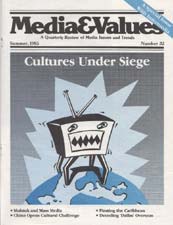Reagan's 'Image-Makers' Redefined the Presidency
|
This article originally appeared in Issue# 32
|
An interview with Gregor Goethals
"In this technological, secular society, we find in television our deepest rituals, rituals that tell us who we are, where we came from and where we're going," believes Dr. Gregor Goethals, professor of art history at Rhode Island School of Design.
Suggesting that popular culture uses ritualistic models, Goethals, speaking recently to the "Friends of Media&Values" in Los Angeles, found two television staples that use evangelical traditions: nightly news programs and Presidential press conferences.
"Presidential press conferences take place in a very special place and time," Goethals said. "There's a very particular setting: the White House. There is also a rhythm and flow. It usually opens with a homily, followed by a question and answer period.
"But I think it performs a much more ritualistic function which is to confirm our sense of trust and worth."
Goethals, author of The TV Ritual: Worship at the Video Altar, pointed out that the President now walks down a long red carpeted hallway before he stands before a podium, flanked by flags – a setting reminiscent of a pulpit in a church.
"Ask yourself if the carpet was green or yellow or had flowers on it. All of these things cannot simply be by accident. Even though images fly by in a split second, every inch of your television screen is information."
Looking at the nightly news programs, Goethals sees a purpose besides informing the public. "Viewers are presented with a series of symbolic reports. We respond not to the concrete event but to those reported symbolic events."
"The reason the networks spend millions of dollars for anchor persons is because they need to embody a sense of confidence and trust," Goethals stressed. "We have so many of those symbolic reports to deal with that we tend to depend on this authority figure to tell us what is important to know."



